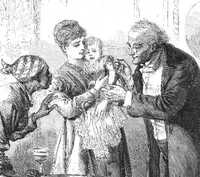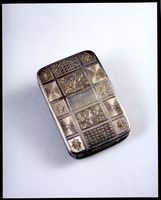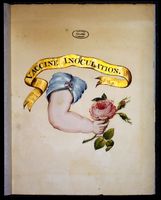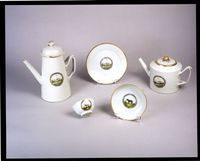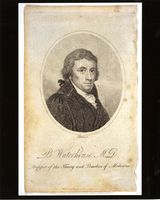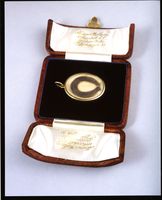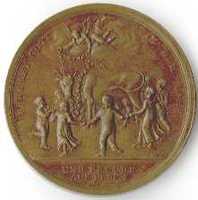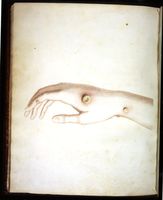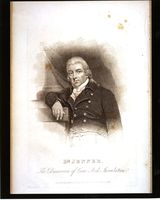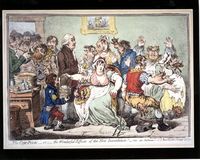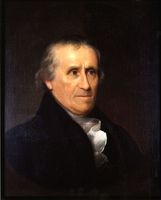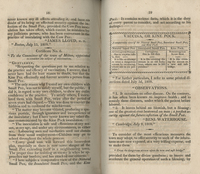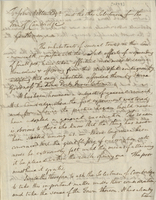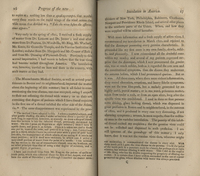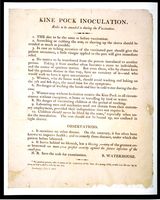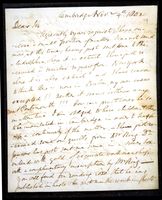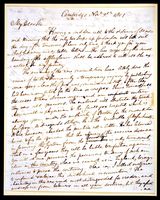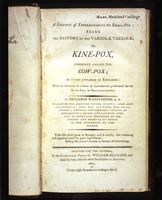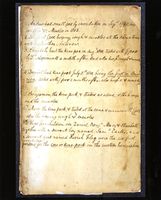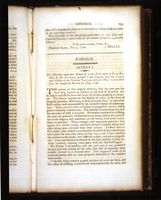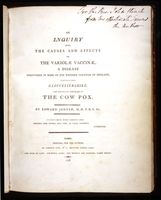Browse Items (23 total)
- Tags: Exhibit: To Slay the Devouring Monster
Sort by:
Vaccinating the Baby
This illustration from a popular New York periodical encourages parents to vaccinate their children against smallpox
Snuffbox
This silver snuffbox was a gift from Edward Jenner to Benjamin Waterhouse and contained quills impregnated with cowpox vaccine matter for use in America. In a letter dated November 16, 1802, Waterhouse said,"Dr. Jenner has been to me what the sun is…
Vaccine Inoculation
This unusual illustration of a child's arm with the distinctive mark of inoculation was inserted in Benjamin Waterhouse's own copy of The Origin of the Vaccine Inoculation (London : printed by D. N. Shury, 1801). The Origin was Edward Jenner's…
Edward Jenner medal
A number of medals were struck to commemorate Edward Jenner's research and the centennial of the first vaccinations. While most depict the physician himself, the bronze example here shows an angel draping a garland around the neck of a cow surrounded…
Hand of Sarah Nelmes
This colored plate appears in the first edition of Edward Jenner's An Inquiry into the Causes and Effects of Variolæ Vaccinæ and depicts the cowpox pustules on the hand of dairymaid Sarah Nelmes. Cowpox matter from these pustules was used…
The Cow-Pock, or, the Wonderful Effects of the New Inoculation!
As the first professional caricaturist in England, James Gillray is usually remembered for his political and royal satires, but this engraving, poking fun at the work of Edward Jenner, shows the dire consequences of injecting cowpox matter into…
Benjamin Waterhouse
This portrait of Waterhouse at the age of 79, attributed to American artist Rembrandt Peale, was on display at the Centennial Exhibition in Philadelphia in 1876.
A Collection of Papers Relative to the Transactions of the Town of Milton
The Selectmen of Milton, Massachusetts, assembled, published, and distributed this assortment of documents to prove the efficacy of vaccination against smallpox and encourage towns throughout the state to establish vaccination programs. Through the…
Letter from Benjamin Waterhouse to John Mellen and the Selectmen of the Town of Cambridge
This letter from Waterhouse proposes that Cambridge initiate a general vaccination program for all its citizens—“adopting that easy substitute afforded them by Divine Goodness”—and vaccinate the poor without charge.
A Prospect of Exterminating the Small Pox, Part II
In this companion pamphlet to his original publication just two years earlier, Waterhouse recounts the popularity of smallpox inoculation following his experiments, as well as the consequent appearance of spurious cowpox matter which caused a…
Letter from Benjamin Waterhouse to Edward Everett
In the 1820s, years after his initial vaccination experiments, Benjamin Waterhouse remained closely involved with the subject. He used this letterbook to keep copies of correspondence with President John Quincy Adams, Daniel Webster, and other…
Letter from Benjamin Waterhouse to Lyman Spalding
Benjamin Waterhouse's position as a supplier of vaccine matter to American physicians is attested in this letter to a colleague, Lyman Spalding (1775-1821). Note that the letter also refers to Jenner's gift to Waterhouse of the silver snuffbox…
Letter from Benjamin Waterhouse to Edward Jenner
In this letter, Waterhouse describes for Jenner the difficulties he has encountered with inoculations of spurious matter and asks for some additional vaccine, specifying that the matter be sent on soaked threads pressed between glass and sealed with…
On the Difficulty of Preserving the Vaccine Virus on Thread or Glass
in Very Hot Weather
Some of the problems associated with the early smallpox vaccination work are highlighted in this manuscript of Benjamin Waterhouse. Without an adequate way to preserve the active virus at high temperatures, Waterhouse often found its efficacy…
A Prospect of Exterminating the Small-Pox
Benjamin Waterhouse's first pamphlet on the subject of his inoculation work appeared in September, 1800, just a few weeks after the vaccination of the Waterhouse children and servants in the summer. The pamphlet describes his early promotion of…
Waterhouse Family Bible
The flyleaves and end papers of Bibles were often used to record the births, deaths, and marriages of family members. But this Bible, belonging to the Waterhouse family, was used to record Benjamin Waterhouse's cowpox inoculations of his children,…
Analytical review of Jenner's "An Inquiry..."
This anonymous article, appearing in December 1798, is the first American publication to discuss the work of Edward Jenner.
An Inquiry into the Causes and Effects of the Variolæ Vaccinæ
The first edition of Edward Jenner's publication contains his evidence that inoculation with cowpox vaccine matter could be a preventive against smallpox. Pages 32-35 concern Case XVII, an eight-year-old named James Phipps, who was inoculated with…

